This article has been reviewed according to Science X's editorial process and policies. Editors have highlighted the following attributes while ensuring the content's credibility:
fact-checked
trusted source
proofread
Country of birth is a key factor in assessing risk for conditions favorable to stomach cancer development

Researchers at Sylvester Comprehensive Cancer Center at the University of Miami Miller School of Medicine have found that country of birth—not just geographic region—is a key risk factor for gastric intestinal metaplasia, a precursor lesion of stomach cancer.
Although stomach cancer—often called gastric cancer—is relatively rare in the United States, it is much more common and deadly among Hispanics, non-Hispanic Black people, Asian Americans and Pacific Islanders than among the white population.
Sylvester and the University of Miami Health System serve a widely diverse racial and ethnic population, including many immigrants, visitors and patients from nations in Latin America and the Caribbean. The findings are based on what is believed to be the largest and most diverse U.S.-based sample of foreign-born patients with what researchers consider a major predisposing condition, the presence of GIM.
"We found that not only is country of birth a key risk factor for gastric intestinal metaplasia, there is considerable variability among countries—even those with geographic proximity," said Dr. Shria Kumar, a clinical epidemiologist and gastroenterologist at the Miller School and a researcher in gastrointestinal cancer risk mitigation at Sylvester. "Recognizing the varied odds of GIM in Latin American and Caribbean countries, we now know that we need to carefully and precisely identify risk by country of birth, and our findings may help shape screening and surveillance programs in the United States and other countries that have large immigrant populations."
According to the study, published in The Lancet Regional Health—Americas, not all countries thought to be in high-risk regions are associated with higher rates of GIM. To tailor future screening and surveillance efforts appropriately, guidelines should account for country of birth, along with other risk factors.
The retrospective study analyzed medical records of 21,108 people from 130 countries who underwent upper endoscopic procedures and gastric biopsy between 2011 and 2021. GIM was identified in 1,699 cases. The authors restricted statistical analyses to countries with at least 100 people, evaluating 15 countries (1,208 cases of GIM). In their analyses, the researchers identified prevalence of HP infection and GIM diagnosis among patients from a variety of Latin American and Caribbean countries. People born in Ecuador, Honduras and Peru were at highest risk of having GIM.
Because gastric cancer is relatively uncommon in the entire population, experts say universal screening would be inefficient and unjustifiably costly, and while targeted screening among higher-risk groups could be cost-effective, more detailed, precise information is needed to identify those for whom screening would be most beneficial. The Sylvester researchers investigated risks and pursued a timing strategy for screening that takes disease progression into account for greatest impact and efficiency.
The years-long or even decades-long process of gastric cancer development often begins with a bacterial infection, Helicobacter pylori (HP), in the stomach. Untreated, infection may progress to chronic inflammation and thinning of the stomach lining, a condition called atrophic gastritis, which may eventually lead to gastric intestinal metaplasia. Because this step, development of GIM, is considered a critical precursor to gastric cancer, and GIM is more prevalent in Asian Americans and Hispanics compared to non-Hispanic white people, experts have identified this stage in the cascade as potentially the best time for screening to identify patients and determine their cancer risk.
"Our study demonstrates that country of birth is a key risk factor for GIM, along with HP infection, race and ethnicity, age, and smoking," Kumar said. "Because some countries in predetermined high-risk regions are not necessarily associated with higher rates of GIM, it's important to study the under-investigated risk factor of country of birth and not rely solely on racial and ethnic minority classification." Kumar is the paper's corresponding author.
Dr. Shida Haghighat, a gastroenterology fellow at the University of Miami and the paper's first author, said that while U.S. guidelines recommend endoscopic surveillance of GIM in racial and ethnic minorities and immigrants from regions with high incidence of gastric cancer, not only is there significant variability in prevalence among subgroups, the term "high incidence" is not well defined. Future studies should seek to build comprehensive risk-prediction models.
"It's clear that we need to more fully identify those at highest risk," she said. "And while one risk factor for GIM may not be sufficient to warrant screening for precancerous conditions, people with multiple risk factors could be considered for screening and surveillance."
In addition to Kumar and Haghighat (last and first authors, respectively) Catherine Blandon and Dr. David Goldberg contributed to the article.
More information: Shida Haghighat et al, Association between country of birth and gastric intestinal metaplasia: a retrospective cohort study, The Lancet Regional Health—Americas (2023). DOI: 10.1016/j.lana.2023.100635





















